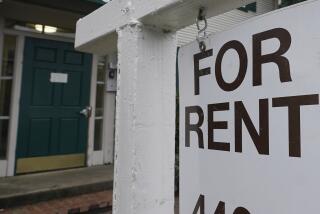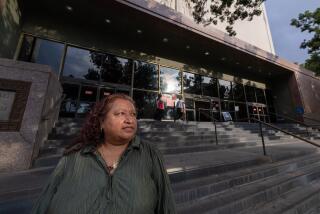Santa Ana Rent Strike: A New Role for Latinos
- Share via
Alfredo Torres put up with leaky faucets, faulty stoves and rats so noisy inside his Santa Ana apartment that they kept his wife and four children awake at night. But when the hot water stopped for six months last year, Torres put his foot down. In November, he quit paying the $350 monthly rent on a one-bedroom Brook Street apartment after the owner neglected to make repairs, he said.
‘We Deserve Better’
“I had my back against the wall. What could I have done? I have my family to consider. We deserve better,” said Torres. Torres is an unlikely leader of an unusual rent strike that has united more than 300 Latino tenants--the majority of whom hold jobs but are in the country illegally.
Housing experts and Southern California community activists say it is the first time in recent years in California or anywhere else in the nation that a group of Latino residents--many here illegally--has been organized in a renters’ strike or has united on such a large scale to demand action from its local government.
The Santa Ana action reflects a new awareness on the part of Latino residents, who may have entered the United States illegally but have lived and worked here for years and want to protect what they have gained. The Torres family is typical of what organizers and city officials now recognize as Santa Ana’s “new families.” No longer viewed as members of a transient population, Torres and his wife, Amelia, have roots: He is a hard worker, pays taxes and all four children, including two who were born here, attend public schools. The couple has lived in the same apartment 10 years.
“You can’t discount these people as transitory residents anymore, because they’re rooted,” says Nativo Lopez, a Santa Ana-based organizer for Hermandad Mexicana Nacional (National Mexican Brotherhood), a Southern California immigrants rights group. “They view their places--those slum apartments--as their homes. And they’ll fight to keep them.”
With the help of Hermandad Mexicana, Torres and other tenant leaders with only a minimal knowledge of tenants’ rights and of how to organize, have succeeded in unifying their neighborhood, surpassing achievements by other community activists and renters’ groups.
“We had to do something, that’s why I decided to help organize the residents here,” said the 43-year-old Torres, who assembles TV cabinets for $4.50 an hour and speaks only Spanish. He expressed anxiety but “no fear” that he might be the first tenant who will have to defend himself in court. Landlord Carmine Esposito of Villa Park this week dropped an eviction action against Torres.
Effort to Borrow Money
Esposito could not be reached for comment. But his attorney, Terence L. Calder of Santa Ana, said that Esposito is attempting to borrow $80,000 to $100,000 to help pay for repairs. In the meantime, the landlord has agreed to postpone any eviction action until next week.
The building in which the Torres family lives and five other buildings owned by Esposito were found “substandard” by a task force of city inspectors who were part of a city crackdown on poor housing conditions.
Tenants announced their rent strike Feb. 4. Since then the City of Santa Ana, attempting to compel Esposito to fix his buildings, has filed two lawsuits accusing him of violating health and safety codes.
Esposito gave 3-day notices this week to striking tenants to pay rent or face eviction. However, Esposito’s attorney said he will wait eight days to make the next legal move.
“But we want to meet and negotiate with any legal representative the tenants have,” Calder said.
In the past, only grass-roots groups like the United Neighborhoods Organization in East Los Angeles and the International Ladies Garment Union in Los Angeles have included undocumented residents in organizing activities. Roberto De La Cruz, an organizer with the United Farm Workers union, said immigrants have been organized elsewhere, but he could not recall any organizations dealing with renters’ strikes.
Illegals’ Numbers Guarded
Hermandad Mexicana organizer Lopez said he is fearful that U.S. immigration officers may threaten the striking tenants with deportation, or that unscrupulous landlords may notify immigration authorities demanding action. Because of those fears, Lopez was reluctant to say how many residents in the local movement are here illegally.
“It’s a national secret,” he said.
Almost half of Santa Ana’s 200,000-plus residents are Latino. Undocumented residents, although never fully counted by census workers, are estimated from 20,000 to 50,000, according to police, immigration, and other sources.
City Councilman Wilson Hart, part of a new council majority, praised Hermandad’s efforts because the group helps residents assert their rights despite “mortal” fears of retaliation from landlords and deportation by immigration authorities.
“I don’t view the tenants as different than any other segment of our community,” Hart said. “Whether we like it or not, those folks are Santa Ana residents. They’re going to be with us for as long as one can imagine. I think the sooner we understand that, the better off we’ll be.”
The renters’ strike and subsequent publicity is in harmony with the city’s goal of cleaning up its old, deteriorating housing stock, Hart said, adding, “What we all want is to clean up the neighborhood.”
‘Call INS? Absolutely Not’
Hart and others on the council said they would never suggest that the city notify the U.S. Immigration and Naturalization Service. That stance reinforces a policy announced in 1983 by Police Chief Raymond Davis of refusing to assist immigration officers, except in a peacekeeping capacity, during sweeps of illegal immigrants.
“Call INS?” said Hart. “Are you kidding? Hell, no! Absolutely not! That would be a mistake in immense proportions.
“How can you win the trust of an important segment of your community if your Police Department is perceived as just another arm of the INS? We have to keep our distance.”
Organizers like Lopez said they ahve known the city’s changing demographics for years and believe they are just now tapping the ranks of the “new families.” Statewide, Hermandad has 10 chapters in other cities, he added.
The renters’ movement is headquartered in a small, cramped Hermandad office on Fifth Street in downtown Santa Ana. There, amid posters of Mexican revolutionary leader Pancho Villa and Martin Luther King Jr., strategy meetings are held and coffee sipped by tenants, Torres and other organizers.
‘All in This Together’
They discuss tenant law, eviction notices and courses of action to take--all in Spanish. “We’re all in this together,” said longtime Santa Ana resident and tenant representative Mario Gonzales, 59.
All tenant representatives have equal voices and chances to bring any concerns affecting their apartment buildings before the organizing group.
“At first we didn’t want to get involved,” Lopez said. “But as more and more of Hermandad’s members became affected by the city’s code enforcement program, we couldn’t get out of it.”
Gilbert R. Melendez, a Santa Ana homeowner and volunteer organizer, said it was the city crackdown on substandard housing that prompted the tenants to seek help. No other group in Santa Ana could have helped them, Melendez said, listing a number of community-based organizations that have become stagnant or that refuse to help non-citizens.
Councilman Daniel Young said he welcomed the organizers’ efforts because they focused even more attention on the city’s aggressive code-enforcement program.
“I think the (uncooperative) landlords need to hear this message and I know that we have the entire support of the community,” Young said.
Political Clout Feared
Melendez isn’t so sure. He is worried that as the city’s crackdown moves to other neighborhoods it could affect influential landlords with political ties.
“We’ve been lucky so far. But what happens when we go up against a prominent landlord who knows people on the council?” asked Melendez.
He pointed out that while organizers have rallied hundreds of tenants to participate in City Hall protests, these residents legally are unable to register to vote.
Young admitted he has given thought to the political consequences, but said he intends to stand by his word.
“The landlords are not going to tell me who I should help and not help. The real issue is . . . the status of their property. If they don’t keep it clean, then we’re going to get involved,” Young said.
So far, the Brook Street apartments represent the city’s biggest cleanup effort. Up to now, housing inspectors have focused largely on single-family homes. As the program proceeds to other blighted neighborhoods with large apartment complexes, some city officials foresee a spirited tenants’ movement at each location.
“I really think it’s a logical thing to happen,” said Philip Freeland, Santa Ana housing director.
Relocation Aid Provided
However, Freeland and other city officials view tenant organizing efforts as positive community activism.
In fact, the city has approved a $100,000 program to provide families with up to $1,500 in relocation assistance in cases where condemnation has occurred. The usual requirement that aid go only to “U.S. citizens” has been amended to “city residents.”
In addition, the Orange County Legal Aid Society has decided to use about $250,000 in interest from a special fund for legal services for “any low-income resident” affected by Santa Ana’s housing crackdown, said the organization’s county director, Robert Cohen.
“We will no longer ask questions about legal or immigration status,” Cohen said. He said the county group’s board decided late last fall to assist poor tenants with the special fund. Under pressure from the Reagan Administration, the society has been restricted since April, 1983, to helping only U.S. citizens with federal funds for legal aid services, Cohen said.
The advent of new social programs has enabled the city staff to work aggressively toward city goals while working closely with the tenants’ social needs, said Rita Hardin, who is in charge of Santa Ana’s code-enforcement program.
‘Exorbitant Rents’ for Garages
“Now we can give money to help people relocate and refer residents to Legal Aid,” Hardin said.
“We see people paying exorbitant rents to live in garages. These people don’t complain and express ignorance out of fear,” Hardin said.
She said that landlord Esposito, before his renters decided to withhold rent, had ignored the city’s warnings to fix up his properties.
“After they announced the strike, though, he came in the very next day, well, almost the next day, and filed plans to fix up four of the six buildings out there,” Hardin said.
“I don’t believe that my words (warnings) were meaningful to him until the city posted a notice to vacate on his property and the tenants organized to withhold rent.”
Socking it to the landlords’ pocketbook--Esposito has said he could lose $28,000 monthly from withheld rent--is the prying tool that tenants hope will help improve housing conditions, Lopez said.
Demonstration Planned
In the meantime, they have set up a special fund to collect rents and have decided on a name, Familias en Accion (Families in Action).
They are planning a demonstration today to support Torres’ battle and have scheduled a benefit dance to raise money for any legal fees Saturday night in a hall at St. Joseph Catholic Church in Santa Ana.
Lopez said he recently asked the tenants if they wanted to stop the strike and pay the rent.
“They said no to both questions. They don’t want to give in. I asked them would they keep the same stand if police should come and move them out. They all said yes.”
More to Read
Sign up for Essential California
The most important California stories and recommendations in your inbox every morning.
You may occasionally receive promotional content from the Los Angeles Times.










